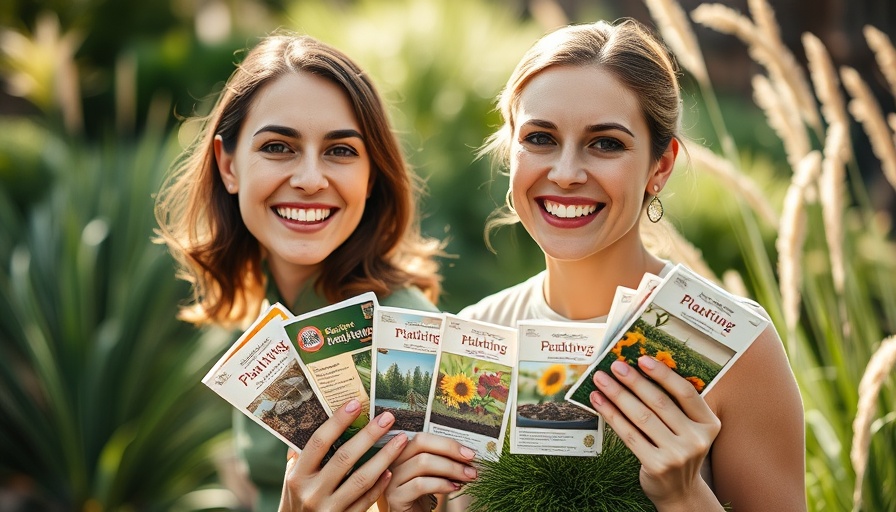
Embracing May: A Gardener’s Guide to Cold Climate Sowing
For Okanagan gardeners, May is a pivotal month where the promise of summer crops begins to unfurl. But when sowing seeds in a cold climate, timing and technique matter greatly. As temperatures fluctuate, understanding how to make the best of your growing conditions can set the tone for a fruitful gardening season. So what can you sow as the spring weather dances between warmth and coolness?
In Seeds You Can Direct Sow in May | COLD CLIMATE, the discussion dives into essential planting techniques for cold climates, exploring key insights that sparked deeper analysis on our end.
Cold-Resistant Crops: Surviving the Chill
When considering which seeds to plant, frost-resistant crops should take center stage. Vegetables like carrots, radishes, and beets aren't just indicated for cool conditions; they thrive in them. These hardy root vegetables often exhibit sweeter flavors when grown in cooler soil, making them an excellent choice for early sowing. Knowing that radishes prefer temperatures as low as 5° Celsius for germination can help gardeners effectively utilize the still-cool conditions of early May.
Leveraging Soil Temperatures for Successful Germination
The ideal growing conditions hinge on understanding soil temperatures. Peas kick off their germination at around 5° Celsius, while spinach and kale can sprout at a mere 2° Celsius. This adaptability allows them to flourish earlier in the season, making them easy picks for planting before the frost has completely passed. If you’re looking to be rewarded with tender, crispy greens, be sure to get these classic cool-weather favorites into your soil soon.
What to Hold Off On: Transplanting and Timing
While some plants thrive in cool conditions, not all seeds are created equal. It's essential to resist the temptation to plant heat-loving crops, like tomatoes and peppers, before the weather permits. These tender plants require nighttime temperatures consistently above 10° Celsius for their survival. As a new gardener, remember that patience can lead to stronger plants; waiting until conditions stabilize can mean healthier transplants later.
Raised Beds and Temperature Control: Advantages for Growth
As Okanagan gardeners know, raised beds can warm soil more quickly than traditional in-ground gardens. This phenomenon allows for an earlier planting window, especially for warmth-loving crops such as cucumbers and winter squash, which need soil temperatures of around 16° Celsius before they can thrive. By utilizing raised beds, gardeners can strategically manage the conditions necessary for a bountiful harvest.
Future Trends: Gardening Adaptations in Changing Climates
Climate change continues to have a significant impact on growing seasons. In regions like the Okanagan, early springs and shifting frost dates may become the norm. Therefore, being adaptable to these fluctuations can become a valuable asset. Curious about the implications of climate fluctuations? Curbing your gardening goals in line with these changes can provide not only resilience but can also spark innovation in gardening practices.
Practical Gardening Tips: Getting the Most Out of Seed Sowing
Effective gardening requires preparation and a keen eye for detail. Prioritize soil preparation as a vital step to kickstart your gardening season. For those spring veggies, ensure that your soil is warm and nutrient-rich; this will assist plants in thriving despite any lingering cold conditions. Additionally, understanding how to manage soil moisture and organic matter can be pivotal in providing those early seedlings with optimal conditions, enhancing their chance for success.
Community Involvement: Gardeners Uniting for a Cause
Finally, as we immerse ourselves in planting and tending our gardens, it’s worthwhile to remember the broader community around us. Local events like charity walks can provide wonderful opportunities to connect, as shown by a recent initiative to support those affected by MS. Engaging in communal activities not only fosters local solidarity but also enriches the gardening experience, reminding us that we are all in this together.
In Seeds You Can Direct Sow in May | COLD CLIMATE, discussions about planting in cold climates offer crucial information for improving your spring gardening experience. Taking heed of the insights shared can help navigate the tricky waters of early sowing for a flourishing summer garden.
 Add Row
Add Row  Add
Add 




 Add Row
Add Row  Add
Add 

Write A Comment